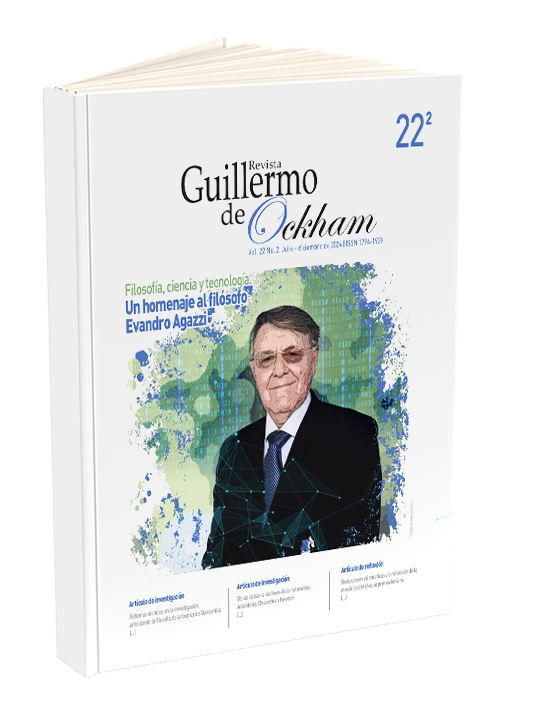La Revista Guillermo de Ockham brinda un acceso inmediato y abierto a su contenido, basado en el principio de ofrecer al público un acceso gratuito a las investigaciones para brindar un intercambio global de conocimiento. A menos que se establezca lo contrario, el contenido de esta revista tiene una licencia con Creative Commons Attribution-NonCommercial-NoDerivatives 4.0 International (CC BY-NC-ND 4.0) http://creativecommons.org/licenses/by-nc-nd/4.0/
- Atribución: debe otorgar el crédito correspondiente, proporcionar un enlace a la licencia e indicar si se realizaron cambios. Puede hacerlo de cualquier manera razonable, pero no de ninguna manera que sugiera que el licenciante lo respalda a usted o su uso.
- No comercial: no puede utilizar el material con fines comerciales.
- Sin derivados: si remezcla, transforma o construye sobre el material, no puede distribuir el material modificado.
- Sin restricciones adicionales: no puede aplicar términos legales o medidas tecnológicas que restrinjan legalmente a otros de hacer cualquier cosa que permita la licencia.
Resumen
Las innovaciones tecnológicas –herramientas, artefactos y procesos– abren nuevas posibilidades de acción humana y, por tanto, aumentan el ámbito de nuestra libertad positiva. La tecnología está intrínsecamente cargada de valores, debido a que este aumento de la libertad puede ser bueno o malo en relación con los valores humanos. El uso de herramientas también puede conllevar subproductos y efectos secundarios no deseados. Por tanto, la tecnología no debe desarrollarse de forma determinista o aleatoria, sino guiarse por principios democráticos razonables. La evaluación de tecnología (TA, por su sigla en inglés) es un patrón de evaluación de proyectos y productos tecnológicos por sus costes y beneficios, riesgos y beneficios. Utilizando como método distinciones y argumentos filosóficos, este artículo explica, elabora e ilustra la fórmula de Niiniluoto TA = 6E + S para la TA. La primera E es la eficacia, la capacidad de la nueva herramienta o solución para producir los efectos previstos. Es la principal preocupación del ingeniero. La segunda es su beneficio económico, basado en el valor de cambio monetario del producto. Este es el ámbito de las teorías económicas. La eficacia y la economía, y la eficiencia como su combinación, no son las únicas dimensiones relevantes de la TA. Como productos del diseño, los artefactos tienen cualidades estéticas, estudiadas hoy en día en la estética aplicada. Las relaciones de las herramientas con la salud de sus usuarios se estudian en ergonomía. Las relaciones de las tecnologías humanas con la salud del entorno natural y el desarrollo sostenible se tratan en ecología. Las herramientas técnicas y sus efectos siempre pueden evaluarse con criterios éticos relativos a su valor moral. Los sistemas tecnológicos también tienen un impacto social en sentido amplio, pues pueden provocar cambios en las esferas comunicativa, jurídica, institucional y política de la sociedad.
Palabras clave:
Referencias
Bijker, W. E., & Law, J. (1992). Shaping technology/building society: Studies in sociotechnical change. The MIT Press.
Buchanan, J. M. (1986). Liberty, market and the state: Political economy in the 1980s. Oxford University Press.
Bugliarello, G., & Doner, D. B. (Eds.). (1979). The history and philosophy of technology. University of Illinois Press.
Carpenter, S. (1983). Technoaxiology: Appropriate norms for technology assessment. In P. T. Durbin & F. Rapp (Eds.), Philosophy and technology: Boston studies in the philosophy of science (Vol. 80, pp. 115–136). Springer.
Durán, J. M., & Pirtle, Z. (2020). Epistemic standards for participatory technology assessment: Suggestions based upon well-ordered science. Science and Engineering Ethics, 26(3), 1709–1746. https://doi.org/10.1007/s11948-020-00211-7
Durbin, P., & Rapp, F. (Eds.). (1983). Philosophy and technology. D. Reidel.
Ellul, J. (1964). The technological society. Alfred A. Knopf.
Elster, J. (1983). Explaining technical change. Cambridge University Press.
Gibbons, M., Limoges, C., Nowotny, H., Schwartzman, S., Scott, P., & Trow, M. (1994). The new production of knowledge: The dynamics of science and research in contemporary societies. Sage.
Habermas, J. (1970). Toward a rational society. Beacon Press.
Hennen, L. (2012). Why do we still need a participatory technology assessment? Poiesis & Praxis, 9, 17–41. https://doi.org/10.1007/s10202-012-0122-5
Ihde, D. (1979). Technics and praxis: A philosophy of technology. D. Reidel.
Kitcher, P. (2001). Science, truth, and democracy. Oxford University Press.
Kotarbiński, T. (1965). Praxiology; An introduction to efficient action. Oxford University Press.
Kutz, C. (2000). Complicity: Ethics and law for a collective age. Cambridge University Press.
Latour, B. (1987). Science in action. Open University Press.
Merton, R. K. (1973). The sociology of science: Theoretical and empirical investigations. The University of Chicago Press.
Michalos, A. (1983). Technology assessment, facts and values. In P. T. Durbin & F. Rapp (Eds.), Philosophy and technology: Boston studies in the philosophy of science (Vol. 80, pp. 59–81). Springer.
Ministry of Education, & Ministry of Employment and the Economy. (2009). Evaluation of the Finnish national innovation system: Policy report. Taloustieto Oy.
Mitcham, C. (1994). Thinking through technology: The path between engineering and philosophy. The University of Chicago Press.
Niiniluoto, I. (1990). Should technological imperatives be obeyed? International Studies in the Philosophy of Science, 4(2), 181–189. https://doi.org/10.1080/02698599008573357
Niiniluoto, I. (1997a). Technology policy in a liberal state. In S. Hellsten, M. Kopperi & O. Loukola (Eds.), Taking the liberal challenge seriously: Essays on contemporary liberalism at the turn of the 21st century (pp. 192–204). Ashgate.
Niiniluoto, I. (1997b). Ciencia frente a tecnología: ¿diferencia o identidad? Arbor, 157(620), 285–299. https://doi.org/10.3989/arbor.1997.i620.1818
Niiniluoto, I. (1997c). Límites de la tecnología. Arbor, 157(620), 391–410. https://doi.org/10.3989/arbor.1997.i620.1823
Niiniluoto, I. (2016). Science vs. technology: Difference or identity? In M. Franssen, P. Vermaas, P. Kroes & A. Meijers (Eds.), Philosophy of technology after the empirical turn (pp. 93–106). Springer.
Niiniluoto, I. (2017). G. H. von Wright on the dangers of technology. In I. Niiniluoto & T. Wallgren (Eds.), On the human condition: Philosophical essays in honour of the centennial anniversary of Georg Henrik von Wright (pp. 421–431). Societas Philosophica Fennica.
Niiniluoto, I. (2020). Tekniikan filosofia. Gaudeamus.
Niiniluoto, I. (2022a). Beauty, truth, and justice: Philosophical essays on culture, science, and society. Societas Philosophica Fennica.
Niiniluoto, I. (2022b). Concepts, experts, and deep learning. In S. Wuppuluri & I. Stewart (Eds.), From electrons to elephants and elections: Exploring the role of content and context (pp. 577–586). Springer.
Sahal, D. (1987). Patterns of technological innovation. Addison-Wesley.
Science and Technology Policy Council of Finland. (1993). Toward an innovative society: A development strategy for Finland. Science and Technology Policy Council of Finland.
Shrader-Frechette, K. (1983). Technology assessment and the problem of quantification. In P. T. Durbin & F. Rapp (Eds.), Philosophy and technology: Boston studies in the philosophy of science (Vol. 80, pp. 151–164). Springer.
Shrader-Frechette, K. (1985). Technology assessment, expert disagreement and democratic procedures. In P. T. Durbin (Ed.), Research in philosophy and technology (Vol. 3, pp. 103–129). JAI Press.
Shrader-Frechette, K. (1991). Risk and rationality: Philosophical foundations for populist reforms. University of California Press.
Skolimowski, H. (1966). The structure of thinking in technology. Technology and Culture, 7(3), 371–383. https://doi.org/10.2307/3101935
Teknologianeuvottelukunta. (2021). Finnish technology policy in the 2020s: A global leader through technology and information. Valtiovarainministeriö. http://urn.fi/URN:ISBN:978-952-367-692-3
Uusitalo, L. (1986). Environmental impacts of consumption patterns. Gover.
von Wright, G. H. (1963). The varieties of goodness. Routledge; Kegan Paul.
Winner, L. (1977). Autonomous technology. The MIT Press.
































